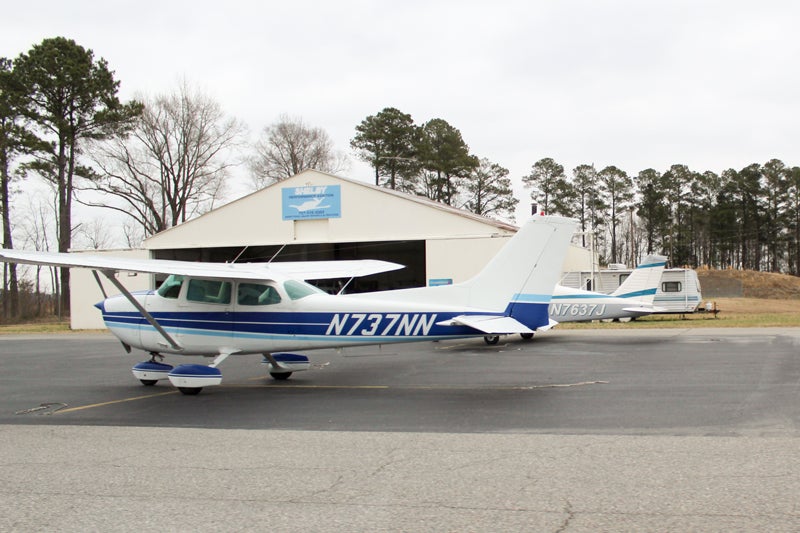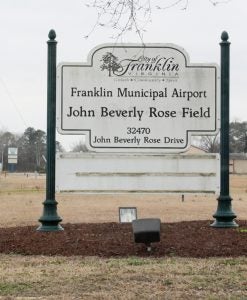Franklin airport to be renamed
Published 6:18 pm Friday, February 8, 2019

- Franklin’s City Council recently voted to rename the city’s airport. Pictured is prop-plane at the facility. Stephen Faleski | Tidewater News
|
Getting your Trinity Audio player ready...
|
FRANKLIN

The sign at the intersection of John Beverly Rose Drive and Carrsville Highway will need to be updated to reflect the airport’s new name. Stephen Faleski | Tidewater News
On Jan. 28, Franklin’s City Council voted unanimously to approve plans to rename the Franklin Municipal Airport.
The proposed new name is the Franklin Regional Airport. The city’s Airport Advisory Board recommended the name change at its meeting on Sept. 5, 2018, citing the need to rebrand the airport as a regional asset that serves not only Franklin but also Isle of Wight and Southampton counties.
With the council resolution passed, the matter will now go before the Federal Aviation Administration and the Virginia Department of Aviation. Over the next few weeks, each agency will review the request and begin the process of updating FAA publications, Department of Aviation licenses and other signage, letterhead and advertising to reflect the new name.
Updating the sign for the airport, located at the intersection of Carrsville Highway (Business Route 58) and John Beverly Rose Drive, is estimated to cost the city approximately $2,400 according to Airport Manager Jimmy Gray. He described this cost as a “ballpark price” that would probably be reduced through the competitive quoting process the city will use.
The current sign lists “John Beverly Rose Field” beneath “Franklin Municipal Airport,” honoring the service of a Carrsville resident and Army helicopter pilot who was killed in a helicopter crash on June 29, 1964, at Fort Belvoir, Virginia. Gray was uncertain whether the new sign for the “Franklin Regional Airport” would still list a separate name for the field, as FAA and Department of Aviation publications will only list one official name. However, he said plans are in the works to construct a memorial to Rose near the terminal building.
The Airport Advisory Board has also asked the city buy a new courtesy vehicle for the airport, which can be loaned to visitors who need transport to and from motels, restaurants, meetings and other business needs. The current courtesy vehicle, a 1998 four-door Ford Crown Victoria formerly used as a Franklin Police car, still functions but is in a well-worn state. According to the recommendation of the Airport Advisory Board, may not give the best impression of Franklin on corporate air traffic that flies in and out of the airport.
Franklin’s City Council has not yet voted on whether to purchase a new courtesy vehicle for the airport, nor has it discussed the cost or type of said vehicle.
The Virginia Department of Aviation defines Franklin’s airport as a general aviation commercial airport, meaning it caters primarily to private aircraft, military aircraft (mostly helicopters), and corporate aircraft. Corporate aircraft, Gray said, may or may not include jets, and refers to business trips in and out of the airport.
“A lot more goes on here than people realize,” he said, explaining that the airport receives a fairly regular amount of corporate traffic, and that the runway has been designed to accommodate most sizes of corporate planes.
The airport handles roughly 12,000 operations per year, Gray said, an operation being either a takeoff or a landing occurring from the hours of 8 a.m. to 5 p.m. As such, this figure does not include nighttime traffic.
Corporate traffic that flies in and out of Franklin regularly includes a company that supplies doctors at Southampton Memorial Hospital, contractors for International Paper, suppliers of local businesses such as Love’s Truck Stop, and even a federal prison in Winton, North Carolina, that uses the airport to transport inmates.
The airport’s origins date to the 1930s when the Great-Depression-era Civilian Conservation Corps constructed a single dirt runway on the site. During World War II, the Navy took over the administration of the airport, expanding it and renaming it Navy Auxiliary Air Station Franklin. After the war, the Navy turned the airport over to the then-town of Franklin. In the 1980s, the city assumed total control and made the airport a city operation.
Editor’s note: A previous version of this story had misidentified the Civilian Conservation Corps as the “Congressional Conservation Corps.”





